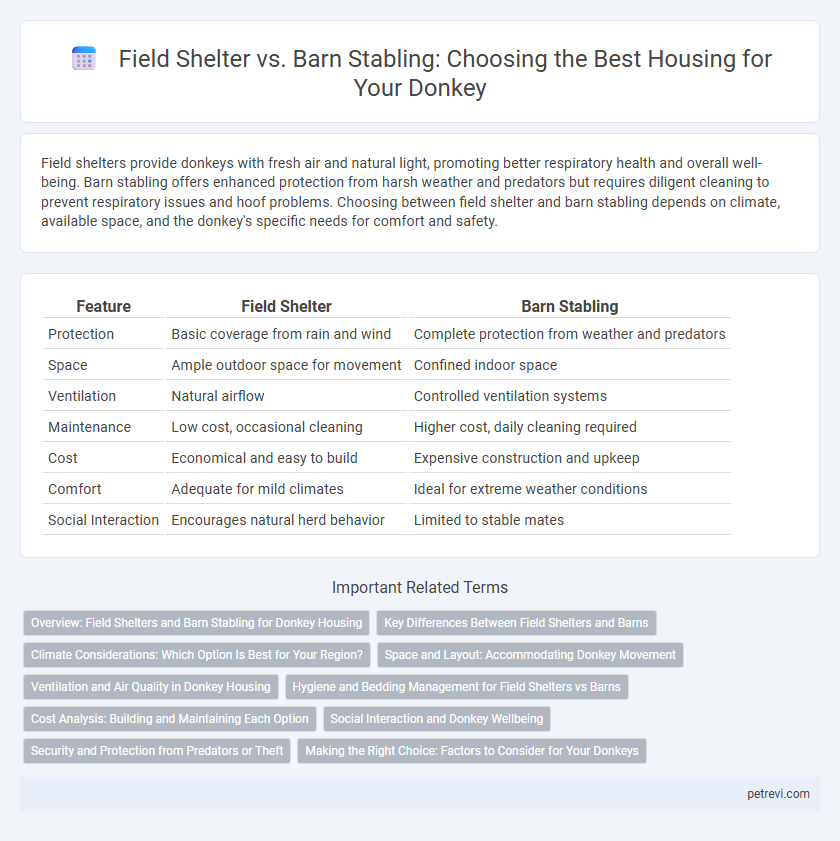Field shelters provide donkeys with fresh air and natural light, promoting better respiratory health and overall well-being. Barn stabling offers enhanced protection from harsh weather and predators but requires diligent cleaning to prevent respiratory issues and hoof problems. Choosing between field shelter and barn stabling depends on climate, available space, and the donkey's specific needs for comfort and safety.
Table of Comparison
| Feature | Field Shelter | Barn Stabling |
|---|---|---|
| Protection | Basic coverage from rain and wind | Complete protection from weather and predators |
| Space | Ample outdoor space for movement | Confined indoor space |
| Ventilation | Natural airflow | Controlled ventilation systems |
| Maintenance | Low cost, occasional cleaning | Higher cost, daily cleaning required |
| Cost | Economical and easy to build | Expensive construction and upkeep |
| Comfort | Adequate for mild climates | Ideal for extreme weather conditions |
| Social Interaction | Encourages natural herd behavior | Limited to stable mates |
Overview: Field Shelters and Barn Stabling for Donkey Housing
Field shelters offer donkeys protection from harsh weather conditions while allowing them the freedom to roam and graze naturally. Barn stabling provides a controlled environment with enhanced security, warmth, and ease of monitoring health and diet. Choosing between field shelters and barns depends on climate, donkey temperament, and management preferences for optimal welfare.
Key Differences Between Field Shelters and Barns
Field shelters offer donkeys open-air protection with natural ventilation, reducing respiratory risks common in enclosed barns. Barn stabling provides enhanced security and controlled climate, beneficial for older or sick donkeys requiring consistent shelter. While barns allow for better management of bedding and feed storage, field shelters typically require less maintenance and promote more natural social interactions among donkeys.
Climate Considerations: Which Option Is Best for Your Region?
Field shelters provide donkeys with essential protection from wind, rain, and extreme temperatures, making them ideal for regions with mild to moderate climates. Barn stabling offers more controlled temperature regulation and protection from severe weather conditions such as heavy snow or intense heat, benefiting donkeys in areas with extreme seasonal variations. Choosing the appropriate housing depends on local climate patterns, ensuring donkeys remain comfortable, healthy, and stress-free throughout the year.
Space and Layout: Accommodating Donkey Movement
Field shelters provide donkeys with ample open space, allowing for natural movement and grazing behaviors, which supports their physical health and mental well-being. Barn stabling offers more controlled environments but often restricts movement, requiring careful design to include sufficient stall size and access to exercise areas. Optimal donkey housing balances protection from harsh weather with spacious layouts that accommodate their need to roam, lie down comfortably, and engage in social behaviors.
Ventilation and Air Quality in Donkey Housing
Field shelters provide superior natural ventilation for donkeys, reducing the risk of respiratory issues by allowing fresh air to circulate freely around the animal. Barn stabling often requires mechanical ventilation systems to maintain air quality, which can be less effective if not properly maintained. Proper airflow in both housing types is essential to prevent moisture buildup and ammonia accumulation, ensuring optimal respiratory health for donkeys.
Hygiene and Bedding Management for Field Shelters vs Barns
Field shelters for donkey housing require regular bedding replacement and thorough cleaning to prevent urine and manure buildup, maintaining hygiene in an open, well-ventilated environment. Barn stabling, while offering protection from extreme weather, demands more intensive daily manure removal and moisture control to reduce ammonia levels and bacterial growth. Effective bedding management in both settings involves using absorbent materials like straw or shavings to ensure dryness, reduce odor, and promote hoof health.
Cost Analysis: Building and Maintaining Each Option
Field shelters for donkeys offer a cost-effective housing solution with lower initial building expenses and reduced maintenance costs due to simple structures, often made from wood or metal frames with open sides. Barn stabling, while more expensive to construct and maintain because of its enclosed design, insulated walls, and need for regular cleaning, provides enhanced protection from harsh weather and predators. Over time, field shelters present savings in both construction and upkeep, but barns may reduce veterinary costs by offering a more controlled environment that promotes donkey health.
Social Interaction and Donkey Wellbeing
Field shelters provide donkeys with constant access to fresh air and natural surroundings, enhancing their social interactions by allowing herd members to stay close and engage freely. Barn stabling offers more controlled environments, protecting donkeys from extreme weather but potentially limiting their movement and face-to-face contact, which can affect mental wellbeing. Optimal donkey housing balances shelter protection with opportunities for social bonding, supporting overall health and reducing stress-related behaviors.
Security and Protection from Predators or Theft
Field shelters provide basic protection for donkeys, offering open-air coverage that deters weather exposure but may leave gaps vulnerable to predators or theft. Barn stabling ensures enhanced security with solid walls, lockable doors, and controlled access, significantly reducing the risk of unauthorized entry or predator attacks. Optimal donkey housing prioritizes secure construction materials and surveillance measures to safeguard animals from environmental threats and potential theft.
Making the Right Choice: Factors to Consider for Your Donkeys
Field shelters provide donkeys with a natural environment, promoting better mental well-being and allowing for more exercise, whereas barn stabling offers protection from extreme weather and predators, essential in harsher climates. Consider factors like climate, pasture quality, disease risk, and the donkey's age or health when deciding between field shelter and barn stabling. Ensuring sufficient ventilation, clean bedding, and easy access to food and water is vital for both housing options to maintain optimal donkey health.
Field Shelter vs Barn Stabling for Donkey Housing Infographic

 petrevi.com
petrevi.com